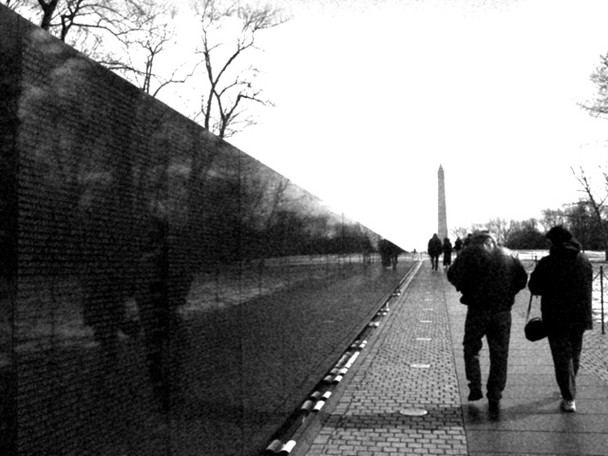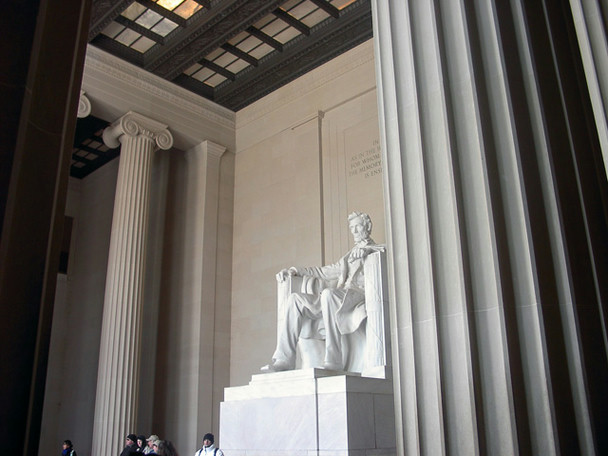Washington, DC part two
United States 2005
On the second morning we arrived back at Union Station, near the east end of The Mall. We were there well before most museums had opened, but we had a mile’s walking before we would be anywhere we wanted to be. We walked west along the northern side of The Mall, past the anonymous machinations of the federal government and august institutions that surround it, and towards the towering obelisk-like monument to George Washington, war hero and reluctant first president of these United States. Even though blue skies were with us and the sun was shining it was bitterly cold — too cold for my bare hands to be anything but stuffed deep inside my pockets and my shoulders hunched. It made taking photographs painful, enough so that I despaired of each worthy view we came across.
We stopped off at the Smithsonian’s National Museum of American History for a few hours. Housed there is the original Star-Spangled Banner, the flag that was hoisted over Boston in 1812 to signal victory over the British — a moment poignant enough for soldier Francis Scott Key to write a poem that would eventually become the nascent nation’s anthem.
Then we passed the George Washington Monument at the centre of The Mall — catching our first glimpse of the White House — and on to the Second World War Veterans’ Memorial. There are many memorials to those who fought in wars-past around the Mall, enough that they threaten to overwhelm it and reduce the significance of each. This memorial takes a lot of space, but doesn’t do much with it; it feels empty. But it does allow the many veterans plenty of room to walk around; some walking with old war buddies, some with their wives, some with a sombre, quiet, intelligent look, and some with a glint in their eye that hints of a kung-ho attitude.

Beyond this memorial is the Reflecting Pool, leading the eye onto the Lincoln Memorial. The famous oblong pool is the scene of many a rally, notably the civil rights marches of the ‘60s and that speech by Martin Luther King. This western side of the Mall is more crammed than the eastern side: the former has wooded curving paths, whereas the latter is mostly open parkland. We curved around until we came upon the Vietnam Veterans’ Memorial. I’m usually stuck in a cynical mindset at war memorials: they often focus on heroic soldiers struggling against evil tyranny, lending a glamorisation to conflict at the expense of the often terrifying and confusing realities of war. This, however, was different. Two walls, fifty metres in length, made a wide V-shape surrounding a bare triangle of grass. The tops of the walls are at ground level, and you walk down a path to where the walls meet. Starting off less than an inch high, the walls get higher until they join at a height of four metres. In the surface of the walls are carved thousands of names: over sixty blocks in each wall, the tallest fifty rows high, each row having five names. These are the names of those who died in the war. When the competition to design this memorial was run, this was the clear winner. The judges chose it without knowing who was the designer; it turned out to be a fourteen-year old Vietnamese girl.

We saw many other things during the day including the Lincoln Memorial, the Korean War Veterans’ Memorial (another poignant memorial with slightly oversized statues of soldiers on patrol looking frightened and tired), the National Buildings Museum, the Smithsonian’s Natural History Museum and Freer Gallery, and of course, a visit to the iron railings of the White House so we could gawp at the US president’s house (it’s smaller than you think — mostly because the Founding Fathers didn’t want the president living in something palatial after they’d spent years getting rid of a monarchy). On our way back towards the bus we stopped off at Ford’s Theatre. On 14th April 1865 President Abraham Lincoln was watching a play there when an actor, John Wilkes Booth, stepped quietly in the box Lincoln was sharing with his wife and two friends and shot the president in the back of the head. Wilkes Booth got away — temporarily — shouting ‘Sic semper tyrannis’ while Lincoln was moved to a house across the street. His wife must have had an awful night there while doctors shuffled in and out, but Lincoln died a few hours later. The theatre still performs, and the house where he died is free to enter, left as it was at the president’s death.
The next morning as we started on our way to New York we stopped off at a few places. I wanted to see the memorial to Thomas Jefferson (who is, I think, my favourite US president) on an island in the Potomac River before we stopped at the National Cemetery in Arlington in time for the changing of the guard. The ceremony was sombre and funny at the same time since the officer in charge of the guard was a bit of a showman and took it all seriously, ending up acting it out as if he was Arnold Schwarzenegger in the Terminator. We also drove past the Pentagon, which is quite simply massive.
Washington was a lot more fun than I thought it would be. For a ‘made-up’ city it has a lot of history, and it’s quite simply stuffed full of things to do — the area around The Mall must be one of the most culture-filled places in the country, and the Smithsonian Institution could take up a week of your time easily. It’s also a city with two sides: the side tourists see (Downtown, Georgetown, and so on) and the side crippled by poverty and crime — for example it has the highest murder rate in the US. The city is almost entirely against the Republican party (it voted 90% for John Kerry in the 2004 election). But enough of the facts; if you get the chance you should make a visit.